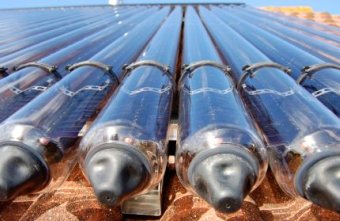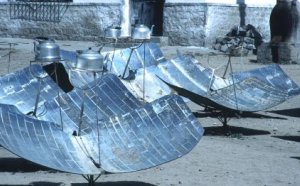- Home
- Solar Energy
- Solar Thermal Energy
Solar Thermal Energy
Freely Available Heat For Our Use!
Solar thermal energy utilises a part of the sun's energy spectrum reaching the earth - the infra-red portion. That part we are aware of as warmth.
Even the visible portion of light energy, when absorbed by a non-reflective surface, converts into heat energy which can enhance solar thermal processes.
Orientation To Sun
The more perpendicularly angled toward the sun a surface is the greater the radiant energy received - such as at the equator. Generally places closer to the zero latitude are hotter.
Latitude in itself is not the only determinant. Visiting say Lima in Peru, which is in an equatorial location, you notice it is not especially hot. Why is this?

Over Lima there is often a layer of high cloud that deflects the radiant energy effect. Similarly we know that sometimes after intense volcanic activity producing stratospheric ash temperatures can be lowered a few degrees locally or even world-wide for up to a few years.

Similarly sloping ground that angles towards the sun's direction - generally south-facing in the northern hemisphere and north-facing the southern - will be warmer and therefore better suited for harvesting solar infra-red energy than flat ground.
Passive Storage
We know that certain materials retain infra-red warmth well. Water does, but also concrete, tiles, etc. And these materials can be used to later release heat once the air temperature drops creating a moderated and prolonged benefit.

Design Considerations
Designing buildings to utilise these effects means we can also reduce heating needs for buildings. And using the relatively more direct overhead angle of the sun in the summer months we can create a cooler home or office at that time of year by using the design of shading eaves to decrease infra-red absorption in the building.
These designs create cooler buildings in summer decreasing the need for air-conditioning - another high demand energy use.
Harvesting Solar Thermal Energy
There are solar thermal energy harvesting systems available that can be used in association with heat pump technology to run air-conditioning service.
For many years people have used solar thermal energy to heat pools, provide hot water for homes and buildings and for hot water showers in camping situations.

We know that dark materials will absorb infra-red light more strongly. So generally the pipes and other collecting systems for this are created in dark colours.
By using angled roof pitches that align more in a north- or south-facing direction, depending on your hemisphere, it is possible to increase this infra-red effect.

Another way to increase the warmth of incident sunlight is by focusing it. We have nearly all experienced this in using magnifying glasses to focus energy.
A more efficient way to reproduce this for energy requirements is by using parabolic mirrors.
The focal point of these mirrors, which can be just simple highly polished metal surfaces, becomes the point of maximum heat. Collecting systems can be located at this point.

As noted in the photovoltaic cell and panel section, this can be utilised in power production. But also it can be used for heating whether for direct effects as above or in cooking food, water, or for other requirements.
Benefits
Solar thermal power generated from focused sunlight generates a much lesser carbon footprint impact on the environment than does the more popular photovoltaic panel method.
Another benefit of thermally generated solar power is that it is not limited to daylight hours.
By heating a material like salts during the day the heat can be stored until the evening. Then the molten salts can heat water or similar materials to drive turbines.
This technology is used in solar thermal power stations both those using a central tower collector and in parabolic mirror collectors.
Solar thermal energy is widely available, can be manipulated to create greater effects, and has greater potential for future power sources than we have already exploited.
- Home
- Solar Energy
- Solar Thermal Energy
New! Comments
Have your say about what you just read! Leave me a comment in the box below.